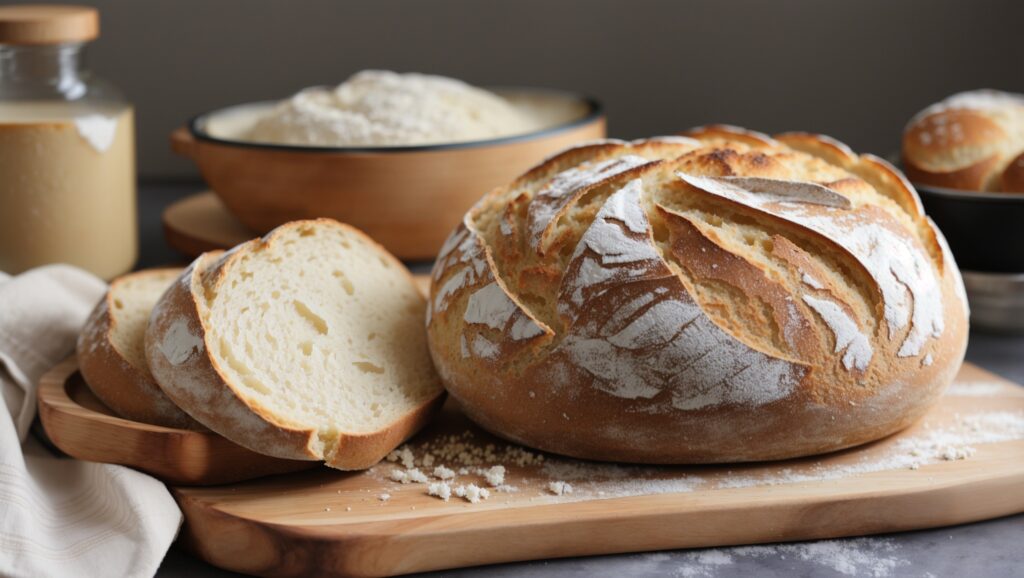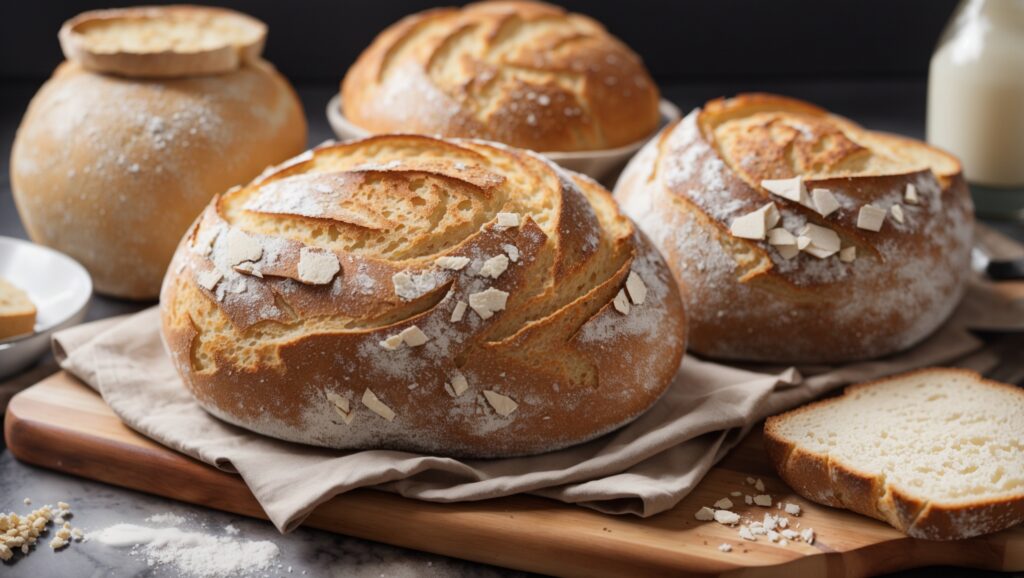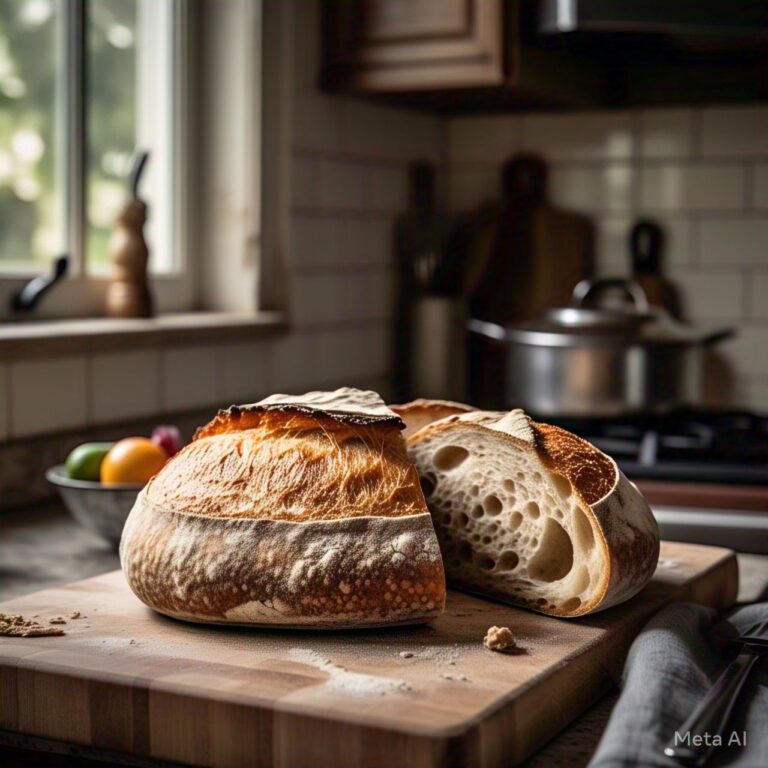Easy Sourdough Bread Recipe
Baking bread from scratch is one of the most rewarding experiences for any home cook. There’s something incredibly satisfying about pulling a freshly baked loaf of bread out of the oven, especially when it’s homemade sourdough. Sourdough bread, known for its tangy flavor and chewy texture, may seem intimidating to bake at first, but with the right approach, it can be surprisingly easy and fun.
In this blog, we’ll guide you through an easy sourdough bread recipe that’s perfect for beginners. We’ll break down the steps, explain the science behind sourdough, and offer tips to ensure that you end up with a delicious loaf every time. So, roll up your sleeves, and let’s get baking.

Key Ingredients for Sourdough Bread
To make sourdough bread, you only need a few basic ingredients. However, the key to successful sourdough bread is your sourdough starter.
Here’s a breakdown of the ingredients you’ll need:
- Sourdough Starter: A mixture of flour and water that has been fermented with wild yeast and bacteria. You can either create your own starter (which takes about a week) or buy one from a bakery or online.
- Flour: You’ll need bread flour or all-purpose flour. Bread flour, with its higher protein content, is preferred for creating a chewy texture in the bread. A combination of both bread flour and whole wheat flour can be used for a more complex flavor.
- Water: The water should be at room temperature. Warm water helps activate the starter, but avoid hot water, as it can kill the yeast.
- Salt: Salt is important for flavor and helps control the fermentation process. Don’t skip this ingredient.
- Optional Additions: Some recipes may call for a touch of sugar or honey to help feed the yeast, though it’s not always necessary for sourdough. Additionally, you can experiment with adding seeds, herbs, or even roasted garlic for added flavor.
Making Your Sourdough Starter (If You Don’t Have One)
If you don’t already have a sourdough starter, it’s easy to make your own. While this process takes about 5-7 days, it’s well worth the effort. Here’s how you can create your own sourdough starter from scratch:
Day 1:
- Combine 100g of whole wheat flour with 100g of water in a glass jar.
- Stir well, cover loosely with a cloth or lid, and leave at room temperature.
Day 2:
- You may not see much activity yet, but that’s normal.
- Discard half of the mixture and add 100g of all-purpose flour and 100g of water. Stir well.
Days 3-5:
- Continue to discard half of the starter and feed it with equal parts flour and water every 24 hours.
- By Day 3 or 4, you should start seeing bubbles and a mild sour smell.
Day 6-7:
- Your starter should be bubbly and active with a pleasant sour smell.
- To test its readiness, take a spoonful and drop it into a glass of water. If it floats, it’s ready to use.
Easy Sourdough Bread Recipe
Once you have your sourdough starter ready (or if you’re using a purchased one), you can begin the process of making sourdough bread. This recipe is beginner-friendly and doesn’t require any special equipment other than a mixing bowl, a dough scraper, and a Dutch oven or baking pot.
Ingredients:
- 1 cup (240g) active sourdough starter
- 3 cups (360g) bread flour (you can also use a mix of all-purpose and whole wheat flour)
- 1 1/2 cups (360ml) room-temperature water
- 1 1/2 teaspoons salt
Step-by-Step Instructions:
Mix the Dough
- In a large mixing bowl, combine the active sourdough starter with the water. Stir to break up the starter and combine it with the water.
- Add the flour, one cup at a time, mixing with your hands or a spoon until all the flour is incorporated into the dough.
- Add the salt and mix until it’s fully distributed in the dough. The dough should be sticky but still manageable. If it feels too wet, you can add a little more flour, but avoid adding too much to keep the dough soft.
Knead the Dough
- Once the dough is well-mixed, transfer it onto a floured surface and begin kneading. You can use the “stretch and fold” method, where you stretch the dough out and fold it back onto itself.
- Knead for about 10 minutes. The dough will become smoother and more elastic as you work with it. If the dough sticks to your hands too much, sprinkle with a little flour, but don’t add too much, as you want to keep the dough hydrated.
- Alternatively, you can knead the dough using a stand mixer with a dough hook attachment on low speed for about 6-8 minutes.
Bulk Fermentation (First Rise)
- Place the dough in a clean bowl, cover it with a damp kitchen towel, and let it rise at room temperature for 4-6 hours, or until it has doubled in size. The fermentation time depends on the temperature of your kitchen and the strength of your starter.
- During the rise, you can perform a few “stretch and folds” every 30 minutes during the first 2 hours to help develop the dough’s structure. This is optional but can help improve the bread’s texture.
Shape the Dough
- After the dough has doubled in size, gently turn it out onto a floured surface. Gently deflate the dough by pressing it down with your hands.
- Shape the dough into a round or oval loaf by folding in the edges and rolling it into a tight ball or boule.
- If you want to shape it into a baguette or batard, roll it into a longer shape. You can use a proofing basket or bowl lined with a clean cloth to help hold the shape while the dough rises.
Final Proof (Second Rise)
- Place your shaped dough into a proofing basket or onto a parchment-lined baking sheet. Cover it with a towel and let it rise for another 2-4 hours at room temperature. You want the dough to puff up and feel airy but not over-proofed.
- Alternatively, you can refrigerate the dough overnight for a slow, cold rise. This will develop even more flavor and make the dough easier to handle.
Preheat the Oven
- About 30 minutes before baking, preheat your oven to 475°F (245°C). If you’re using a Dutch oven, place it inside the oven while it preheats.
- If you’re baking the bread on a baking sheet, place a baking stone or pizza stone in the oven while it preheats.
Bake the Bread
- Once your oven is hot and the dough has finished its final rise, carefully transfer the dough onto a piece of parchment paper for easy handling.
- If you’re using a Dutch oven, carefully place the dough into the preheated pot (with the lid on) and place it in the oven. If you don’t have a Dutch oven, place the dough directly onto the baking stone or sheet.
- Bake the bread with the lid on (or in a covered pot) for 25 minutes, then remove the lid and bake for another 20-25 minutes until the loaf is golden brown and sounds hollow when tapped on the bottom.
Cool the Bread
- Once the bread is baked, remove it from the oven and let it cool on a wire rack for at least 1 hour before slicing. This allows the crumb to set and the flavor to fully develop.
Tips for Success
- Use an active starter: Ensure your starter is bubbly and at its peak of fermentation. A weak starter will result in a dense loaf.
- Don’t rush the rise: Sourdough bread takes time to rise. Be patient and allow the dough to ferment and rise properly for the best flavor and texture.
- Use the “stretch and fold” technique: This helps strengthen the dough’s gluten and contributes to the final texture of the bread.
- Preheat your oven: A hot oven is crucial for a good rise and a crispy crust. Make sure your oven is fully preheated before placing your dough inside.
- Experiment with flour: You can experiment with different types of flour (like whole wheat, rye, or spelt) to change the flavor and texture of your bread.
What Is Sourdough Bread?
Before we dive into the recipe, let’s take a quick look at what makes sourdough bread so special.
Unlike bread made with commercial yeast, sourdough bread relies on wild yeast and lactic acid bacteria to ferment the dough. The wild yeast, which naturally occurs in flour and the environment, ferments the dough slowly. This long fermentation process gives sourdough its distinctive tangy flavor and chewy texture. The lactic acid bacteria, which thrive during fermentation, add to the unique sourness of the bread.
Sourdough bread is not only flavorful, but it also has a lower glycemic index than bread made with commercial yeast, making it easier to digest. Plus, the slow fermentation process helps break down gluten, which may make it a better option for some people with gluten sensitivities.

Conclusion
Sourdough bread might seem like a daunting challenge at first, but with this easy recipe and a little patience, you’ll be able to bake a delicious loaf of homemade sourdough. The process may take some time, but the result is a tangy, chewy, and aromatic bread that’s perfect for sandwiches, toasts, or just eating on its own with a bit of butter.
Whether you’re a beginner or an experienced baker, sourdough bread is a rewarding project. So go ahead—gather your ingredients, prepare your starter, and get ready to enjoy the wonderful process of making sourdough bread from scratch. Happy baking.
If you want to explore whole site CLICK HERE.
What is the best easy sourdough bread recipe for beginners?
The best easy sourdough bread recipe for beginners involves a simple mix of sourdough starter, flour, water, and salt. Let the dough rise for 4-6 hours, shape it, and then bake it in a preheated oven at 475°F.
Can you share an easy sourdough bread recipe?
Mix 1 cup active starter, 3 cups flour, 1 1/2 cups water, and 1 1/2 teaspoons salt. Knead, let rise for 4-6 hours, shape, rise again, and bake at 475°F for 25 minutes covered, then 20 minutes uncovered.
What makes an easy sourdough bread recipe great?
An easy recipe uses few ingredients, minimal kneading, and simple rising times, making it perfect for beginners to bake a flavorful loaf without complex techniques.
How can I make an easy sourdough bread recipe with minimal ingredients?
Use just sourdough starter, flour, water, and salt. Mix, knead, let it rise, shape, and bake at 475°F for a delicious, simple loaf
Can you recommend an easy sourdough bread recipe for a perfect loaf?
Yes, Mix starter, flour, water, and salt, knead, and let rise. Shape, rise again, and bake at 475°F for a perfect, golden crust.
What are the key steps in an easy sourdough bread recipe?
Mix ingredients, knead, let rise, shape, rise again, and bake. This simple process results in a delicious loaf with minimal effort.
Why is an easy sourdough bread recipe great for new bakers?
It’s simple, requires basic ingredients, and doesn’t involve complicated techniques, making it perfect for beginners to make flavorful bread.
Is there an easy sourdough bread recipe with a short fermentation time?
Yes, Use a more active starter for faster rise times, aiming for a 4-hour bulk rise and a quick second rise before baking.
What is the best easy sourdough bread recipe for beginners?
The best easy sourdough bread recipe for beginners is one that doesn’t require complex techniques or a lot of ingredients. Start by using a simple sourdough starter, flour, water, and salt. Let your dough rise slowly and give it time to develop flavor. One straightforward recipe includes mixing equal parts of your sourdough starter, water, and flour, then allowing the dough to rise for 4-6 hours. Shape it, let it rise again for a few hours, and then bake in a preheated oven. Keep things simple, and focus on allowing your dough to rise at the right pace for the best results.







